
The US dollar has remained world’s reserve currency since the end of World War Two. Dollar had fractional gold-backing, forcing an expansionary limit to its money supply.
Dollar was as good as gold, just more liquid. Every country chose dollar treasury bills over holding gold, as holding T-bills paid interest. Gold didn’t.
The US started building its Military Industrial Complex and took on adventures like the Korean and Vietnam War, running huge fiscal and trade deficits, putting pressure on dollar’s fixed peg to gold. In 1971, Nixon was forced to close the gold window.
Dollar was no longer as good as gold, but it had already become a widely used reserve currency and the most liquid trading asset.
Central banks of other countries were left holding the dollar-denominated treasury bills. They couldn’t simply sell them and buy gold because there just wasn’t enough gold in the world to buy with those T-bills. Or in other words, those T-bills weren’t worth what the exchange rate was telling them.
Since 1973, the US Fed got a blank cheque from the foreign central banks to expand its money supply, via reserves and commercial lending. Gold was no longer the bottleneck. Currencies were floated freely against each other.

Gold shot up from $35 to $615 before the prices stabilised. The markets had spoken and the emperor was declared naked.
But the world continued to accept US T-bills for its export to the US since oil was sold in dollar. There was a huge demand for T-bills in the international market to accommodate the growing international trade. It was necessary for the US to run huge trade deficits, and later accounts deficits, to produce more and more IOUs – or so the story goes.
With the closing of the gold window, the game had now been changed. Credit creation, just like money creation, was now counted in GDP growth just like any industrial growth. In measuring GDP growth, there was no difference between manufacturing machines and manufacturing credit/debt. In reality, real goods make societies rich. Debt makes societies poor via interest payments.
Interest payments are not profits but mere transfer of payments. Markets compete for capital and whichever sector is most efficient in producing profits, would see capital flow in its coffers. Industries producing consumer staples, construction material and machinery see their cost of raw material go up due to money dilution via federal debt monetisation and private credit creation.
Meanwhile, commercial banks see their business grow as financing needs of businesses and individuals grow due to the very inflation private credit creates. Profits for banks rise but those of the non-financial economy falls.
It should be no surprise to any policy-maker that the reason why the US lost its manufacturing base since the 1970s was due to currency debasement which was being entertained by a rapidly growing financial sector. Electronics and appliance manufacturing was being replaced by financially structured products and electronic credit creation.
After all, the cost of producing commercial paper is far less than the cost of producing real goods.
There would have had been a reckoning to all these financial shenanigans if the dollar was not a reserve currency. There wouldn’t have been a need for foreign central banks to buy US T-bills.
The bond markets would have reacted, interest rates would have soared and the currency would have devalued. But for the bond market to react, the capital has to flow somewhere and that somewhere only exists in non-dollar denominated capital markets which are nowhere as deep and liquid. Using derivatives, the central bankers have cornered the global bond vigilantes.
This trend of driving real economic businesses out of business and the growth of financial services sector would continue to create income disparity in the US for the years to come. A world reserve currency, which was supposed to bring prosperity to the US and stability to the rest of the world, has brought social inequality, income disparity and a police state to Americans and the rest of the world.
The writer is a Texas-based equity, bonds and derivatives trader
Published in The Express Tribune, January 28th, 2013.
Like Business on Facebook to stay informed and join in the conversation.

















COMMENTS
Comments are moderated and generally will be posted if they are on-topic and not abusive.
For more information, please see our Comments FAQ